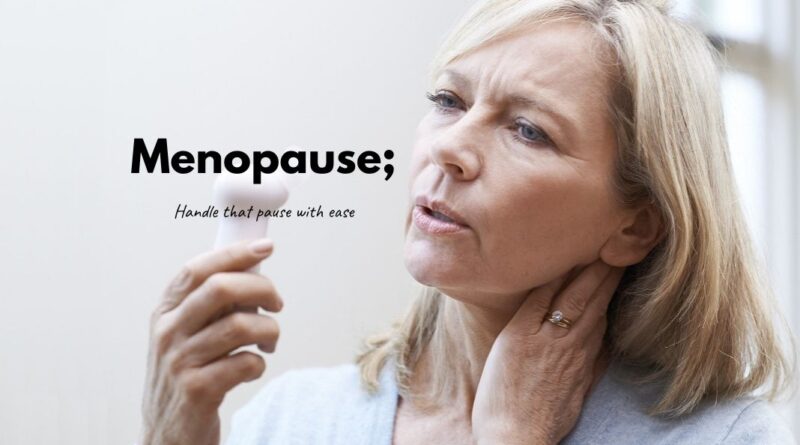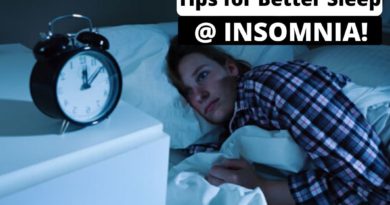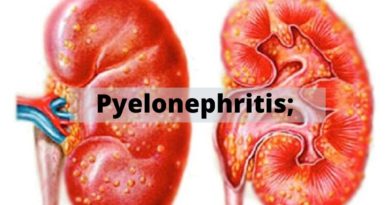Hit Pause to Menopausal Cramps: Top Natural Remedies to Treat Menopause
“A woman must wait for her ovaries to die before she can get her rightful personality back. Post-menstrual is the same as pre-menstrual; I am once again what I was before the age of twelve, a female human being who knows that a month has thirty-days, not twenty-five, and who can spend every one of them free of the shackles of that defect of body and mind known as femininity.” ― Florence King
Ever seen your aunt or mom get super-moody all of a sudden?
Do they constantly feel ‘hot flashes’ and exhausted all the time?
Have they complained about not getting their periods for quite a few months now?
Maybe they’re experiencing what is commonly called ‘menopause.’ Simply put, menopause defines the end of a woman’s fertility as periods gradually stop to occur altogether.
It can be accompanied by a variety of physical and psychological symptoms. Physical symptoms include hot flashes, sweats, tiredness, headache, insomnia, joint pain, hair loss, dry skin, vaginal dryness, among other things; whereas, psychological symptoms vary, from anxiety, reduced sex drive, to irritability and depression.
So, if you’ve mentally tick-marked a majority of these issues while reading, the chances are that you are heading towards the menopause phase.
In the United States(1), approximately 1.3 million women become menopausal each year. It typically begins between the ages of 51 and 52. However, about 5% of women experience early menopause between the ages of 40 and 45. Additionally, 1% of women experience premature menopause before the age of 40, due to permanent ovarian failure that may be associated with sex chromosome abnormalities.
Typically, there are three types of menopause to consider: natural (when estrogen and progesterone decline naturally), premature (when menopause occurs before the age of 40), and artificial (which occurs due to surgical treatments). Contrary to popular belief, males and females, both experience menopause but in different ways, of course. In the case of males, testosterone production reduces, often due to hypogonadism.
All things said and done; it is important to remember that menopause is as natural as aging and can be tackled painlessly to the extent possible. So let’s look at the top home remedies you can try to welcome this new stage in your life.
Table of Contents
Did You Know!
| The average age for menopause is 51-years-old.(2) |
The Different Stages of Menopause
As a thumb rule, menopause is characterized by four stages:
Stage 1: Perimenopause (Before)
This stage starts occurring at least three to five years before you hit menopause (typically at the age of 40). Its symptoms include insomnia, hot flashes, night sweats, vaginal discomfort, urinary issues, and mood swings. Lifestyle changes can help deal with these symptoms at this stage.
Stage 2: Early Menopause
This stage occurs due to events, such as a hysterectomy (when the uterus is removed), oophorectomy (ovaries get removed), or due to premature ovarian failure, which basically signals towards underactive ovaries.
Stage 3: Menopause (During)
Menopause occurs when you’ve missed your period for 12 months straight. Remember that the transition from stage 1 to stage 3 can take up to three years.
Stage 4: Postmenopause (After)
The last stage occurs one year after the periods stop. This stage includes all the usual symptoms of menopause as well as brings with itself an increased risk for heart disease, osteopenia, and osteoporosis, so extra care must be taken.
Natural Remedies for Menopause
- Essential Oils
- Foods
- Alternative Treatments
- Supplements
CURE 1: Essential oils for menopause
First things first, it is important to understand that menopause disrupts day-to-day activities. So, taking allopathic and strong medicines is not feasible. Luckily, there are many essential oils, such as CBD oil for menopause that can come to your rescue. While they are known for their aromatherapy benefits, they can provide relief from anxiety, hot flashes, and other menopausal symptoms.
Important: Essential oils are found in oil or cream forms. It can either be inhaled through a diffuser or applied topically after diluting it with a carrier oil, such as olive, coconut, etc. Remember that under no circumstances should you ingest essential oils.
1. Clary Sage Oil
Clary Sage oil is native to the Mediterranean Basin and can be used as a skin balm, thanks to its refreshing scent.
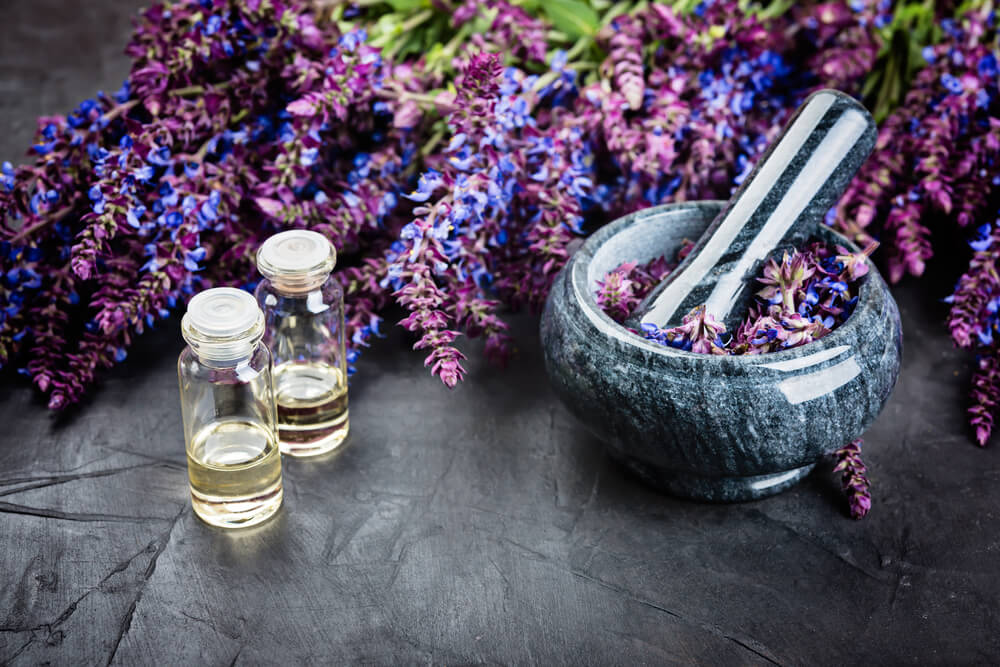
Why does this work?
Studies(3) suggest that Clary Sage oil can delay the development of osteoporosis.
How to use and how much to use?
If you are experiencing frequent hot flashes, simply rub three drops of diluted (in a carrier oil) Clary Sage oil at the back of your neck and at the soles of your feet, or you can inhale a few drops via a diffuser for instant relief.
2. Lavender Oil
Lavender is one of the best essential oils to improve sleep quality and relax you from the inside out. If insomnia has been one of your primary concerns, be smart and add lavender diffusers to your nighttime routine.
Why does this work?
Lavender oil is known to provide comfort to perineal issues while balancing out the hormones effectively. Plus, it comes in handy if you’re experiencing anxiety, heart palpitations, as well as headaches.
How to use and how much to use?
If you’re someone who has been struggling with extreme discomfort around the perineal area, add one drop of diluted lavender oil to a cold compress, and apply on the affected area for around thirty minutes. Make sure to consult a doctor before you apply this oil in any form or before inhaling it.
3. Peppermint Oil
An aromatic herb belonging to the mint family of plants, peppermint oil is native to North America and Europe.
Why does this work?
Peppermint oil works towards reducing hot flashes and provides relief in the case of cramps, which typically occurs during the perimenopause stage.
How to use and how much to use?
You can add two drops of peppermint oil to a tissue and inhale it.
A Helpful Formula to Tackle Mood Swings
You can combine these herbal combinations, however, please consult your doctor before doing so to understand any unknown side-effects:
- Two parts vervain.
- One part wild yam.
- 1 part chaste tree berry.
- One part St. John’s wort.
- One part lemon balm.
CURE 2: Foods for Menopause
A healthy and balanced diet for menopause is essential to keep the uncomfortable symptoms at bay. Here are the top five foods you should include in your diet to expedite weight loss during menopause and boost your metabolism.
1. Flaxseed for Menopause
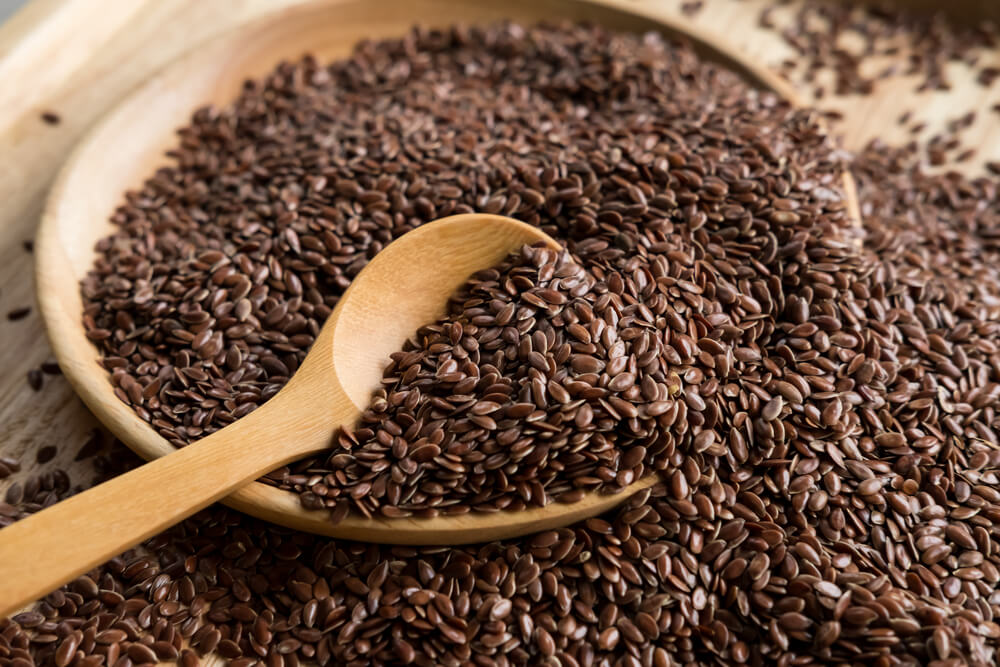
Flaxseed for menopause is like water for our bodies, absolutely essential. Why? This little seed is full of important nutrients, such as omega-3s, fiber, phytoestrogens, and B vitamins.
Why does it work?
Studies(4) claim that the intake of flaxseed helps to lower menopausal symptoms. Plus, it helps ease the discomfort related to night sweats as it is a good source of lignans. Lignans help to balance the female hormones effectively.
How to use and how much to use?
It is available in the oil, supplement, and raw food form. You can drink water-infused with flaxseed early morning for best results. Here’s the process: Take a tablespoon of golden flaxseeds (not the dark brown ones) in half a glass of water. Let it soak overnight. Drink the water and the seeds (optional) first thing in the morning as all the important nutrients, such as zinc, vitamin E, Omega 3, and Phyto-oestrogens, in the flaxseeds, will get absorbed into the water.
Alternatively, you can chew flaxseed raw as an evening snack. For the oil and supplement forms, please consult your doctor to understand the recommended dose.
2. Broccoli
Broccoli is a cruciferous vegetable that is known to have positive effects on the estrogen levels in a woman’s body.
Why does it work?
Broccoli comes power-packed with calcium that ensures strong bones and is full of fibre that prevents flatulence and weight gain caused due to menopause.
How to use and how much to use?
There are numerous ways in which you can integrate broccoli into your daily diet, such as making salads, a bowl of soup out of it, or simply by sauteing it with butter.
3. Yogurt
We all know that the probiotics in yogurt can enhance your gut health and aid in better digestion, boost your immunity, and improve the texture of your skin. But, with menopause, maintaining bone health becomes your priority. This is there the regular intake of yogurt can help.
Why does it work?
Yogurt is rich in calcium and vitamin D and can help fortify your bones and prevent osteoporosis as well as improve your sleep quality. In fact, studies suggest that calcium and vitamin D rich foods such as yogurt can lower early menopause risk by 17 percent!
How to use and how much to use?
One bowl of yogurt twice a day is sufficient to provide you with the necessary nutrients your body needs.
4. Berries

Did you know that dark berries can benefit women going through menopause as it contains phytoestrogen naturally? Plus, blueberries or ‘brain berries’ as they are commonly known can help in improving brain function and preventing memory loss (a common side effect of menopause).
Why does this work?
Berries help to combat fat, reduce heart risks, and decrease inflammation in the body. No wonder that it is often referred to as a ‘superfood.’
How to use and how much to use?
You can make a refreshing smoothie or add it to your morning breakfast routine for a fresh start to your day. Best of all, you can also have it raw along with other nuts.
5. Eggs
Eggs are known to reduce cholesterol levels, lower body weight, and reduce the risk of heart issues. Simply, adding eggs to your diet is an absolute must if you’re menopausal.
Why does this work?
Eggs are full of iron, B Vitamins, and Vitamin D, making it a potent source for proteins, especially for women who don’t eat meat.
How to use and how much to use?
There are a million egg recipes floating on the Internet that are healthy, tasty, and easy to make.
Handy Tip:
It is recommended that you go for cage-free organic eggs for the best results.
Due to menopause, the vaginal tissues and urethra can lose their elasticity. This can cause involuntary loss of urine, sometimes after coughing, laughing, or lifting during menopause!
Recipe Corner: A DIY Sage and Raspberry Tea for Menopause
The process:
- Take ½ tablespoon each of fresh sage and raspberry leaves or ¼ tablespoon each of dried sage and raspberry leaves.
- Wash the leaves thoroughly and place it in a pan.
- Add 200 ml of water to it and bring to a boil. Let it steep for eight to ten minutes.
- You can add stevia, honey, or maple syrup to enhance the taste.
Handy Tip:
Sip the tea and try consuming it, well after you’ve eaten your meal as raspberry leaves can prevent iron absorption in the intestines.
CURE 3: Alternative Therapies
During the different stages of menopause, women experience a host of issues, such as lowered estrogen levels, decreased progesterone, lower endometrium, lesser eggs, an erratic menstrual cycle, and finally the cessation of ovulation.
As scary as these may seem, there are home remedies in place that are backed by science and that you can try to help ease a number of menopause symptoms.
For instance, acupuncture for menopause for a period of five weeks can help tackle menopausal symptoms such as hot flushes, night sweats, sleep disturbances, and emotional issues according to a Danish study. So let’s look at some other home remedies that you can try and understand how they can benefit you.
1. Yoga for Menopause

Why does it work?
A lot has been spoken about the benefits of yoga in general, but yoga for menopause is extremely beneficial. It can help deal with hormonal imbalances and get rid of hot flashes, anxiety, fatigue, irritation, muscle, and joint pain, etc.
There are multiple restorative and supportive poses that can come to your aid and relieve any underlying stress you may be experiencing. Plus, data claims that yoga can boost your memory, focus, and attention spans while improving your sleep quality. Since memory loss can happen as the menopausal stages progress, this fact comes in handy.
How often should you do it?
You can try the following yoga poses and practice as often as possible to reap the maximum benefits: Big Toe Pose, Bridge Pose, Dolphin Pose, Standing Forward Bend, Plow Pose, Camel Pose, Child’s Pose, Down-Ward Facing Dog, among others. Please consult your doctor before trying any of these poses as a safety measure.
2. Avoiding Triggers
Why does it work?
Living a conscious lifestyle can make all the difference when it comes to reducing the intensity of menopausal symptoms. From dealing with hot weather and avoiding non-spicy food to limiting caffeine and alcohol intake are some steps you can take towards more holistic living. Additionally, stress and tight clothing double up as ‘hot flash triggers’ and should be avoided at all costs.
How often should you do it?
It goes without saying that adopting a healthier lifestyle is not a matter of a couple of days. It is a change that should be adopted for life, as seamlessly as possible for maximum benefits.
3. Tai Chi

Why does it work?
Tai Chi is an example of mind-body therapies which offer a plethora of benefits, such as offering physical strength, balance, and flexibility for women. Tai Chi is known to possess cardiovascular(5) benefits, lower inflammation, aid in weight loss, and lower your blood pressure.
It can also enhance your mood and lift up your spirits if you’re feeling particularly anxious or depressed. For all intents and purposes, Tai Chi can be thought of as a softer form of martial arts. There are a number of exercises and styles available which form a part of the Tai Chi routine, but the five major styles include Yang, Chen, Wu/Hao, Wu, and Sun.
How often should you do it?
Make sure to practice Tai Chi for at least 15 minutes a day every day.
4. Meditation and Breathing Exercises
“The goal during mindful moments is not to empty the mind but to become an observer of the mind’s activity while being kind to oneself. The second step is to create a pause. Take a deep breath and observe one’s own space, thoughts, and emotions non-judgmentally. The resulting calm helps lower stress,” Dr. Richa Sood, Women’s Health Specialist
Why does it work?
Data(6) predicts that ‘mindfulness’ can help deal with the irritability, anxiety, stress, and depression in a better manner. So, if you’re looking at ways to develop good psychological health, mindfulness is key.
How to do it and how often should you do it?
If hot flashes have become an everyday reality, you should definitely try deep, slow abdominal breathing and aim for six to eight breaths per minute. Additionally, try deep breathing and meditation for fifteen minutes each in the morning and the evening, to calm your body and mind, and thereby keep anxiety at bay. Self-care during the onset of menopause becomes more a necessity than an option.
5. Massage
Why does it work?
Therapeutic massages can promote blood flow, activate the body’s lymphatic system, reduce fluid-retention and inflammation, and lower tightness in muscles and joints. Plus, it can alleviate anxiety and improve your sleep quality. In fact, studies show that postmenopausal women engaging in regular massages slipped into REM sleep more quickly.
Basically, they experience deep, slow-wave sleep for longer periods of time. As you may have guessed, this is essential for the mind and body’s restoration and rejuvenation.
How to do it and how often should you do it?
Try getting a massage done twice a week to keep depression and anxiety in control.
Data suggests that moderate-to-severe night sweats and hot flashes may last as long as around 10.2 years(7).
CURE 4: Herbs for menopause
Herbal teas and natural remedies for menopause are much-preferred as they are safe and cheaper alternatives. This makes sense as the perimenopause period can last between ten months to four years. Now imagine if you resigned to popping pills each time new menopausal symptoms cropped up. Your body would be a mess, right? Try these herbal remedies to treat menopause for a change and see the difference for yourself.
Important: Please consult your doctor before consuming these herbs in any form as a safety measure.
1. St. John’s Wart
Since time immemorial, this herb has been in use in Europe to treat a variety of health issues, such as mood disorders, anxiety, OCD, insomnia, PMS, eczema, and seasonal affective disorders. However, today, it is mostly used to treat depression.
Why does it work?
If you’re suffering from mild depression, St. John’s Wart should be your go-to herb. Studies claim that it is as effective (if not more) as antidepressants! Plus, it is also known to work its charm and reduce those deadly mood-swings!
How to use and how much to use?
Combine this herb with black cohosh root for best results. To treat depression, certain clinical trials used 300 milligrams of St. John’s Wort, thrice a day for up to six months. Please consult your doctor to understand the correct dose for you as it may have some uncommon side-effects that you need to be aware of.
2. Black Cohosh Root
One of the most famous herbal alternatives for treating menopause, black cohosh root, stands up to its reputation.
Why does it work?
It is known to reduce vaginal dryness and reduce hot flashes in women. In fact, research claims that if you’re experiencing early menopause, stock up on this herbal powder. Interestingly, it is also used as an alternative to Hormone Replacement Therapy.
How to use and how much to use?
It can be consumed in pill or tea forms; however, the latter is preferred. Pregnant women or women with blood pressure and liver conditions should not consume this herb in any form.
3. Ginseng
Ginseng is a God-send when it comes to treating common menopause symptoms, such as night sweats, hot flashes, low mood, and risk of cardiovascular diseases(8).
Why does it work?
The Chinese believe that Ginseng, ‘brightens the eyes, enlightens the mind, and increases wisdom’ as it comes with restorative properties. Ginseng is also known to increase the sex drive in women, reduce stress, fatigue, physical exhaustion, and increase stamina in addition to improving sleep quality.
How to use and how much to use?
You can consume Ginseng in the tea form. Here’s the recipe to make your own tea: Put one teaspoon ginseng powder and add eight cups of water in a pan. Bring to a boil and let it simmer for an hour.
Then, add 9.4 gm whole liquorice root, 28 gm dried ginger root, and two more cups of cold water. Finally, bring the tea to a boil, reduce the heat, and let it simmer for another thirty minutes; strain and drink. Please seek expert advice to understand the right dose for you and get clarity on its side effects.
4. Red Clover

If you’re looking for a healing and balancing herb that can treat high blood pressure, improve bone strength, and boost immunity, red clover is for you. This herb is native to Asia and Europe, and is naturally sweet-smelling.
Why does it work?
Red clover effectively tackles the dual side-effects of menopause, hot flashes and night sweat, as it contains phytoestrogens, calcium, chromium, copper, iron, magnesium, manganese, phosphorus, potassium, selenium, silicon, sodium, cobalt, nickel, and tin. That’s not all. It comes power-packed with vitamins, such as A, B-complex, B2, and C. All these nutrients help to improve hormonal imbalances that occur due to menopause.
How to use and how much to use?
You can make a red clover tea and drink it. Simply take one cup of water and boil it. Then, add one tablespoon of fresh or dried red clover flowers, and let it steep for ten to fifteen minutes: strain and drink. You can add honey to it to enhance its taste.
CURE 5: Supplements
Taking the right vitamins for menopause can significantly reduce the discomfort experienced on a day-to-day basis and provide immediate relief. Here are the top four supplements that you should try after consulting your doctor, of course!
1. Magnesium for Menopause
Not many people are aware of this, but your magnesium levels tend to dip during menopause. Hence, replenishing your body with magnesium is of paramount importance.
Why does it work?
Integrating magnesium-rich foods helps to strengthen the bones and prevent menopausal symptoms, such as osteoporosis, insomnia, tissue dryness, mood swings, anxiety, irritability, and water retention. That’s not all. It also helps to boost your energy levels, a big plus if you ask us.
How to use and how much to use?
Natural foods that are full of magnesium are brown rice, spinach, lentils, quinoa, oatmeal, kidney beans, bananas, whole-wheat bread, tofu, pumpkin, almonds, cocoa powder, and chocolate. Various spices such as dillweed, sage, coriander, fennel seed, and tarragon are also rich in magnesium content.
For the supplement form, the University of Maryland Medical Center suggests that you take 320 milligrams of magnesium per day. Please consult your doctor before taking any supplement to understand its dosage and any side-effects it may have.
2. Vitamin E
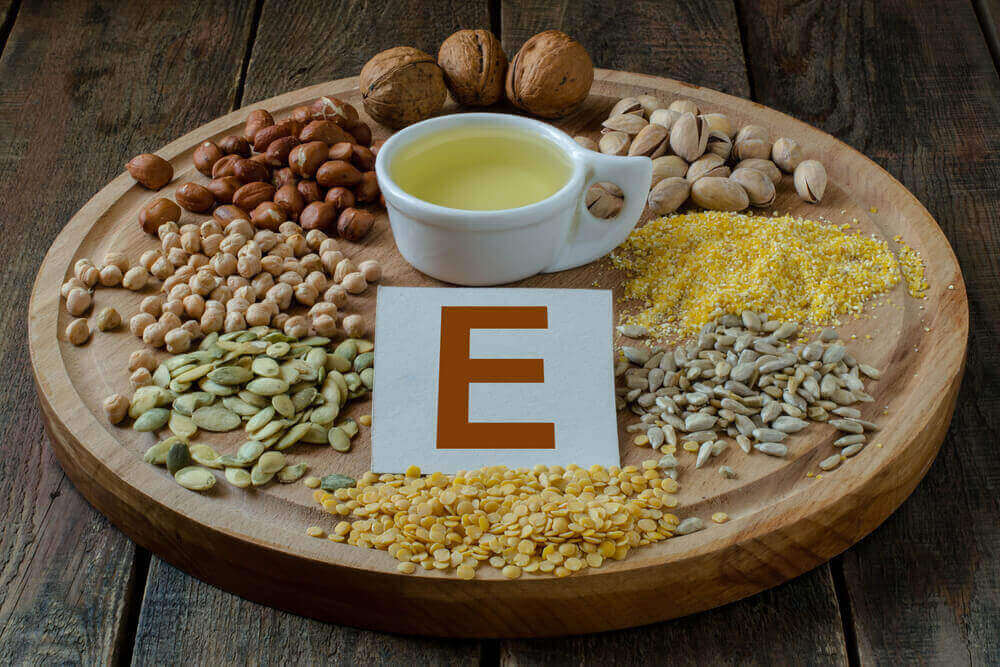
Did you know that low levels of vitamin E can lead to depression if research is to be believed? Simply, vitamin e is not only beneficial for the skin but also helps in treating menopause issues.
Why does it work?
Vitamin E comes with antioxidant properties and works wonders to reduce stress in women experiencing menopause. Since the hormone levels go imbalanced, the cortisol levels are bound to go up, causing stress and mood swings.
How to use and how much to use?
Itis recommended that you consume vitamin e in the natural food form instead of taking supplements. Vitamin E-rich foods include nuts, sunflower seeds, spinach, broccoli, kiwi, mango, and tomato, to name a few.
3. Calcium and Vitamin D
Menopause often leads to a low bone density in women, which can cause osteoporosis.
Why does it work?
We all know that in order to maintain good bone health, getting a healthy dose of calcium and vitamin D is absolutely essential. In fact, studies(9) suggest that an adequate intake of these two supplements can reduce the risk of hip fractures in women.
How to use and how much to use?
There are plenty of calcium supplements, and you can try taking it in the tablet form. Plus, try including these calcium-rich foods in your diet, such as seeds, cheese, yoghurt, sardines, salmon, beans, lentils, almonds, milk, etc. For vitamin D, the best thing you can probably do for your body is to spend time outdoors and get out in the sun.
Alternatively, you can try vitamin D supplements or eat foods, such as fatty fish (tuna, mackerel, and salmon), orange juice, soy milk, beef liver, cheese, egg yolks, among others. Studies suggest that women under 51 years of age should consume 1,000 milligrams of calcium a day, whereas women over 51 of age should consume 1,200 milligrams a day.
4. Phytoestrogens
Phytoestrogens can decrease the intensity and frequency of hot flashes and decrease the risk of heart issues for women suffering from menopause.
Why does it work?
Phytoestrogens are natural plant compounds that have the same effects as estrogen in the body. Basically, they double up as hormone-balancers. In fact, Japanese women tend to experience low hot flashes during menopause (a rarity) due to a high intake of phytoestrogen in their diet.
How to use and how much to use?
Try to include phytoestrogen-rich foods that are readily available at your disposal in your diet instead of consuming supplements or consuming processed foods with ‘added’ soy protein. Natural foods such as soybeans, tofu, tempeh, flaxseeds, linseeds, sesame seeds, and beans work best and provide the right nutrition for you. That said, please consult your doctor to understand the daily dosage based on your requirements and body type.
Side-Effects
Make no mistake to think that menopause comes without any side-effects. Here’s a list of common side effects you may experience.
- Hot flashes signified by sudden heat sensations in the upper body.
- There is a link between menopause and anxiety.
- Weight gain due to a build-up of fat around the abdominal area.
- Irregular periods range between too-frequent periods to not having periods for months at a time.
- Low fertility displayed due to decreased levels of estrogen.
- Vaginal dryness and vaginal atrophy (inflammation of the vagina), which is characterized by extreme dryness, constant itching, and discomfort in the vagina may lead to painful sex.
- Night sweat, which is actually hot flashes that happen during sleep.
- Psychological issues, such as depression, mood swings, and anxiety.
- Reduced cognitive functioning resulting in difficulty to concentrate and focus.
- Insomnia where women face trouble falling asleep, thanks to the night sweats and anxiety.
- Increased chances of Urinary Tract Infections (UTI) and frequent urination.
- Hair loss due to hormonal changes.
Complications Due to Menopause
- Cardiovascular issues: Reduced estrogen levels can increase the risk of heart issues.
- Osteoporosis: Menopause leads to a decreased or low bone density in women, which can increase the chances of osteoporosis.
- Breast cancer: Post menopause, the chances of breast cancer increase significantly. However, regular exercising can reduce this risk.
Also Read: Menopause: alternative treatments to THS
Menopause: Putting the Top Five Myths to Rest
Myth 1: Menopause is a disease.
Fact 1: It is not. It is simply a natural life transition that is inevitable and unavoidable.
Myth 2: Menopause doesn’t require medical treatment.
Fact 2: In cases of premature menopause, medical intervention and natural complementary therapies may be required.
Myth 3: If the periods stop, women can’t get pregnant.
Fact 3: Using contraceptives to avoid pregnancy is highly recommended for women (above 50 years of age) till at least a year passes without a natural period and for two years for women (below 50 years of age) who haven’t experienced natural periods.
Myth 4: Hot flashes is the only symptom of menopause.
Fact 4: Menopause can trigger a number of physical and psychological symptoms that require a more comprehensive approach to ensure healing.
Myth 5: The periods suddenly stop one day.
Fact 5: The menopausal transition lies anywhere between three to five years and differs from person to person.
Also Read: 7 things you need to know about menopause
Dos & Don’ts
Dos |
Don’ts |
| Stop smoking during menopause as it can make the symptoms worse. | Don’t stop using condoms as women can get pregnant during the perimenopausal stage. |
| Do go for routine check-ups to ensure everything is hale and hearty inside. | Don’t compromise on your sleep at any cost and try to maintain a regular bed-time and wake up time. |
| Do stick to a healthy diet and keep yourself hydrated. Adding meditation to this can be the cherry on the cake. | Don’t stop aerobic, strengthening, and balancing exercises and deep breathing as it can worsen menopause’ symptoms. |
| Do take the time out to create a comprehensive lifestyle program – one that involves lifestyle changes and natural ways to deal with menopause. | Don’t ignore your body’s signals; this includes bouts of anxiety and depression, which are often accompanied by menopause. |
| Do spend more time outdoors, amidst nature as it can significantly boost your mood and keep you happy from the inside out. | Don’t dread menopause and waste time worrying about your physical appearance as once the symptoms subside and the hormones even out, you’ll feel better than ever! |
Around 75% of women tend to experience hot flashes during menopause, making it one of the most common side-effects of menopause.
First things first, different women experience menopause differently. But whatever be the case, menopause, in the truest sense of the word, can feel like the end of an era. So it should be tackled with a holistic mindset, one that caters to the physical problems as well as the psychological issues that crop up. All in all, instead of dreading it, you should welcome it.
Trust us when we say that a little change in perspective and armed with all these natural remedies, tackling menopause will be a breeze.
In the off chance that none of the above mentioned natural treatments is working in your favour, please consult a doctor for understanding the next steps you should take.
Also Read: What Is Menopause? Symptoms, Causes, Treatment, and More
FAQ’s
1. What to take for menopause?
There are a number of natural therapies, lifestyle changes, and medical treatments you can undertake to treat menopause and its related symptoms. These include (but are not limited to): hormone therapy, natural supplements, maintaining a healthy diet, avoiding stress and mood triggers, regular exercising, herbal remedies, talk therapy, among other things.
2. How to test for menopause?
Generally, doctors order the person to take a blood test to check the levels of Follicle-Stimulating Hormone (FSH) and Estrogen.
Remember that during menopause, if the FSH levels are consistently elevated to 30 mIU/mL or higher, and you have not experienced a natural menstrual flow for over 12 months, it is accepted that you have reached menopause. Plus, if the Estrogen levels shown in the report are on the lower side, it may indicate a natural progression towards menopause.
3. How long does menopause last?
Post the onset of menopause; the symptoms may last anywhere between four to five years, though note that the symptoms do decline in intensity and frequency with time.
4. When does menopause start?
Typically, women reach menopause between the ages of 45-55 years. However, in rare cases, it may occur in women as early as her 30s or 40s or sometimes, it may not occur even as late as the woman touches her 60s.
5. Do men go through menopause?
Yes, you read that right. Male menopause is a real thing, only that is known as an androgen, which signifies a decline in male testosterone levels as they age. Along with this, they may also experience fatigue, weakness, depression, and sexual issues.

